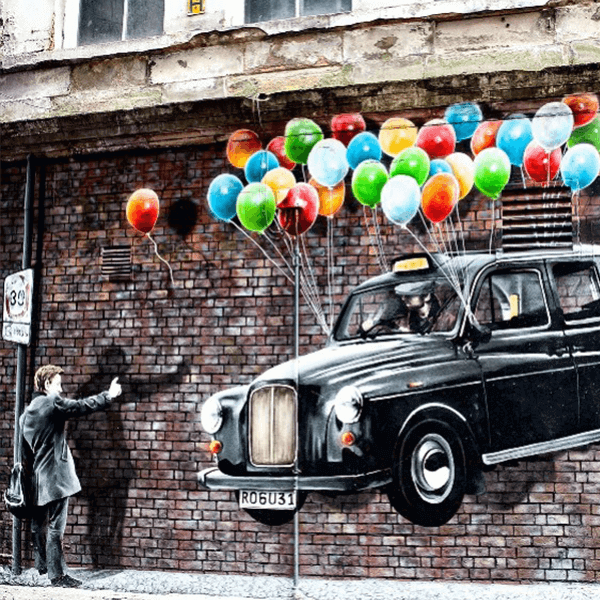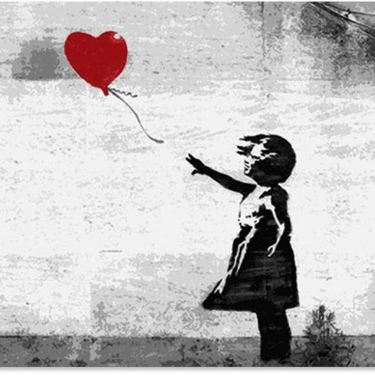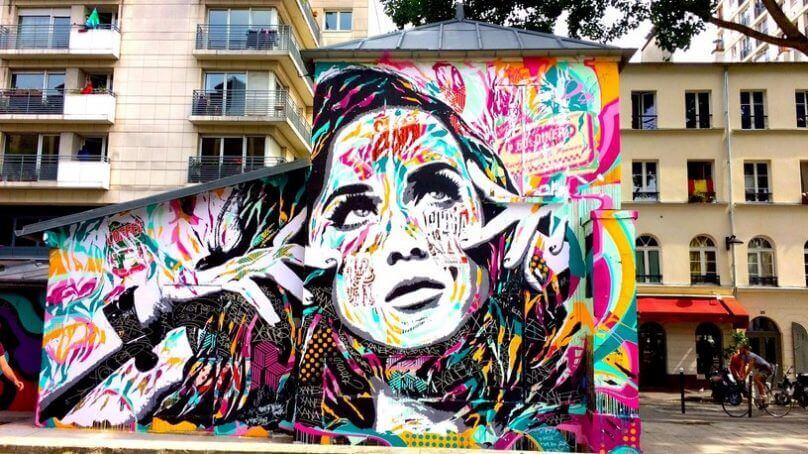5 famous artworks of street art

What is street art?
The birth of street art: two theories
The goal was above all to be able to transmit religious, political or personal messages. It is a real means of expression which has just been born to pass on information, to make people react and especially to think about mentalities on the space which surrounds us.
1. Jef Aerosol, Chuuuttt !!!
4.png)
Jef Aérosol's self-portrait is located next to the IRCAM, the Centre Pompidou and the Saint-Merri church. It overlooks the Stravinsky fountain, which clashes with the machines of Jean Tinguely and the Nanas of Niki de Saint-Phalle. This gigantic stencil of 350 m2 inaugurated in June 2012 was to be destroyed in early 2014 due to the renovation of the wall. March 2016, not only is the stencil still there, but it is inserted into the urban landscape and becomes a quasi-heritage work.
2. Thoma Vuille, M. Chat

Thoma Vuille began painting in the street with acrylics at the age of 15, in memory of his grandfather, a house painter2. After a professional baccalaureate in civil engineering3, he studied at the Institut d'arts visuels d'Orléans from 1995 to 20012. He became known as the author of the Mr. CHAT series, graphic creations representing a yellow-orange cat with a broad smile, usually done with acrylic paint on walls.
The idea came to him in 1997 during a workshop in a school in Orleans during which a little girl drew a cat that inspired the artist. He then undertook to paint his cat on the walls of the city of Orleans, preferably on the roofs, with the sole objective of "putting some human and love in the city: Orleans was a rather gray city and we needed a little bit of sunshine everywhere "4. He intends to convey the optimism of this animal with a broad smile. He signs his works with a mysterious "Mr. CHAT", to "know if a drawing can live without a creator "5. He thus suggests that behind these graffiti lies a collective of artists6. Thoma Vuille then began an international career.
3. Banksy, The Little Girl with the Balloon

4. JR, Inside Out Project
1.png)
French street artist, JR adorns the walls of the world with his huge black and white portraits of anonymous people. Initiated in 2011, his Inside Out project was born thanks to the American TED prize that the artist received for "changing the world".
5. iHeart, Nobody likes me
3.png)
Symbol of a hyper-connected society, the work of the Canadian artist iHeart brings us back to the quest for a very current e-reputation. Or how a crying child, smartphone in hand,
Street art beginnings in New-york
In 1980 a law was established to punish the blunderers. The most courageous will then go to paint in the underprivileged districts of New York, rather than in the city itself. This is how the art of graffiti spreads to other big American cities like Chicago, Los Angeles or Washington, with the same spirit in mind: freedom of expression.
The arrival in Europe
However, the "New York" street art will definitely find its place in Paris and will be displayed in privileged places such as the quays of the Seine, the fences of the Louvre or the Georges Pompidou Center. The clandestine dimension awakens the interest of many street artists who devote themselves to the practice. The colors and the subjects are becoming more and more crazy and the panel of techniques is expanding.
3 Techniques used in street art
The graffiti

The pochoir
Artists like Blek or MissTic wanting to differentiate themselves from the New York tags will illustrate themselves in this practice. The speed of execution being essential for street artists, the art of stencil offers the advantage of multiplying the same pattern many times in a record time.
The collage
From the street to museums
Born in the obscure corners of cities, labeled as an illegal and marginal practice, street art has nonetheless earned its letters of nobility and an unprecedented legitimacy. For the past ten years, Street Art has been exploding and exhibiting itself. The Grand Palais and the Fondation Cartier in Paris, the Tate Modern in London and the MOCA in Los Angeles: the greatest cultural venues are snatching up the works of urban artists. Among the great names of today's street art, Shepard Fairey, Banksy and the Frenchman JR make up the top three of the most paid artists.
Faced with this integration, opinions are divided. If some see it as a deserved recognition, others deplore the sign of a gentrification and the loss of the sulphurous aura of this art. However, several enthusiasts and specialists militate for a better visibility of street art in museums. The President and Founder of the Artistik Rezo association, Nicolas Laugero Lasserre, has lent a hundred works from his collection to give birth to Art42 in Paris, the first street art museum in France. For this enthusiast: "The essence of Street Art, these are militant walls, but in parallel there is a work of workshop. There is a coherence of the two.
A unique and affordable offer

Therefore, whether you are a novice or already passionate about art, whether you plan to bring a unique atmosphere to your wall decoration or create a thrill to a loved one, you will surely get your happiness among our paintings. We opt for the definition of unique prices. This applies to all our artists regardless of the method adopted. These rates are defined according to an objective factor which is that of the size of the painting, in order to create a complete transparency between our artists and you, to thus mitigate the generally obscure coasts of the sector of the art.
Do you need help to find your favorite painting?
You can contact our customer service directly at 04 86 31 85 33 or even make a free 15-minute appointment by videoconference with an art curator.


























